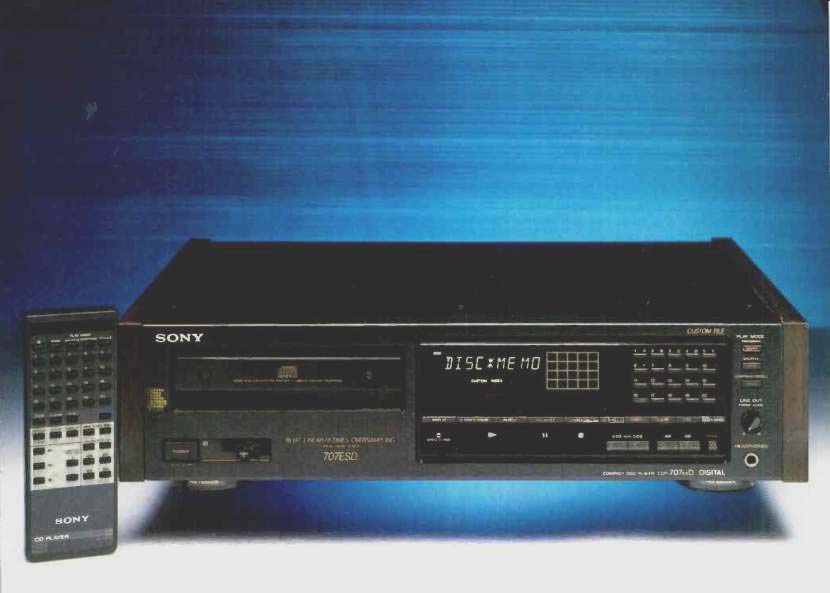
Manufacturer's Specifications:
Frequency Response: 2 Hz to 20 kHz, ±0.3 dB.
Signal-to-Noise Ratio: 115 dB (EIAJ).
Dynamic Range: 100 dB (EIAJ).
THD: 0.0015% (EIAJ).
Separation : 110 dB (EIAJ).
Wow and Flutter: 0.001% wtd. peak (EIAJ).
Number of Programmable Selections: 20 (see text).
Number of Discs Unit Can "Recognize": 226.
Number of Customized Index Points per Disc: 6 (see text).
Output Level: Fixed, 2.0 V rms; variable, 0 to 2.0 V rms.
Digital Output: Coaxial, 0.5 V peak to peak; optical, per EIAJ Standard.
Headphone Output Level: 28 mV.
Power Requirements: 120 V a.c., 60 Hz, 18 watts.
Dimensions: 18 1/2 in. W x 4 15/16 in. H x 14 3/4 in. D (47 cm x 12.5 cm x 37.5 cm).
Weight: 39.6 lbs. (18 kg).
Price: $1,800.
Company Address: Sony Dr., Park Ridge, N.J. 07656.
If you have been wondering just how much more a manufacturer could do to extract every last bit of recorded information from a Compact Disc without introducing extraneous noise or distortion, I commend to you Sony's latest state-of-the-art CD player, the CDP-707ESD. Frankly, I am still a bit dazed after measuring and listening to this unit. I thought that the industry had gone about as far as it could with some of the latest high-end CD players that have appeared recently. I was wrong. The CDP-707ESD beats anything I've ever measured or heard--and not by a small margin, either.
I am just thankful that it arrived after I acquired my Audio Precision System One test gear; otherwise, I might never have been able to measure the residual noise and distortion levels that this incredible player exhibits.
Before I tell you about the measurements and the sonic excellence of this unit, I want to discuss some of its more attractive convenience features. Several of these are almost beyond belief, but trust me, they all work as described.
Perhaps the most outstanding of these are the "Disc Memo," "Custom Index," and "Program Bank" features. "Disc Memo" allows you to compose a message of up to 10 letters, numbers, or symbols and have the message memorized with respect to a specific disc. The stored message is then shown in the front-panel display whenever you load that particular disc. If you wish, the message can be displayed during play as well. "Custom Index" allows the player to memorize up to six index points on each disc as a way of marking your favorite musical passages. These personal index points are in addition to any specific index points that the record company may have encoded onto a given CD, and they can be applied even to discs that have not been so encoded by the manufacturer. What a boon for those of us who own a lot of early CDs, many of which are without index points. The "Program Bank" allows you to program favorite selections from a given disc into the CDP707ESD's memory, in any order you choose. Once you do that, any time you load a disc for which a program has been "banked," the unit will automatically play only those selections you have stored. Any of these features can be applied to as many as 226 different discs. "Disc Memo" and "Custom Index" or "Disc Memo" and "Program Bank" may both be filed for any given disc, but you cannot use "Custom Index" and "Program Bank" simultaneously for a disc.
If all of this sounds as though the age of the read/write or erasable CD has arrived, rest assured that it has not. You see, every CD that's ever been made has its own identifying code. When you use any of the three features I've just described in the Sony CDP-707ESD, the player reads the unique identifying code associated with the disc and stores that code along with your programming or memo instructions. Then, the next time that disc is loaded, the player's microprocessor matches the code to the programs that have been stored for that code.
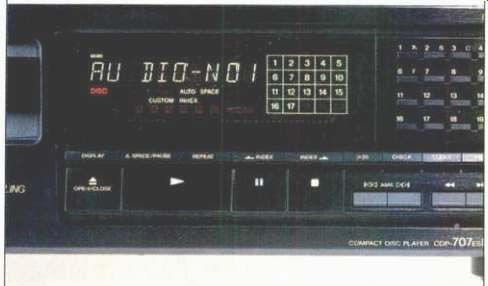
above: "Disc Memo" allows you to assign a message of up to
10 characters to each CD; every time a disc is loaded, its "memo" is
displayed on the player's front panel.
Of course, the more familiar operating features found on earlier Sony (and other) CD players are here too. Up to 20 tracks (or tracks plus index points) can be programmed in any order for immediate playback. As a further enhancement, you can also perform a "Program Edit." That is, you can program a sequence of selections with a built-in pause point. For example, you might create program minutes long with a built-in pause at 25 minutes. During playback, the CD will automatically pause at the end of the first part (25 minutes) and will resume, to play the second part of your program, when you press the "Pause" button.
The popular "Shuffle Play" (random play) feature introduced by Sony more than three years ago has been retained, and it too is augmented. Now you can instruct the player to "Shuffle Play" only those tracks or selections that you want. This feature, called "Delete Shuffle," is aptly named: After requesting "Shuffle Play" mode, you designate the tracks that you don't want included by its use. Incidentally, this unit will play the 3-inch CDs too.
Fast audible search is available, and access time to any point (track or index) on a disc remains under 1 S, as in earlier top-of-the-line Sony CD players.
Circuit Refinements and Construction
For all of these useful and impressive convenience features, of even greater significance, in my opinion, are the circuit improvements and structural refinements that have been incorporated in the CDP-707ESD. This player is the first that I know of to employ eight-times oversampling. Sampling, in a digital audio system, is the process of looking at incoming waveforms as a series of discrete events in time. The speed of this process is the sampling rate. In a digital filter, the sampling rate is the rate at which the filter reads and calculates binary values, outputting them as a data stream to the D/A converter or converters.
In general, as the sampling rate increases, high-frequency performance is improved, output waveforms become more linear, and phase shift and losses due to steep analog filtering at the output of the system are minimized. The use of digital filtering and oversampling doesn't provide any more real data from a Compact Disc, as some have suggested. Rather, the filter creates its own additional data, producing a given number of "calculated" output levels for every "real" value read from the CD (which carries data recorded at the standard sampling rate of 44.1 kHz). In doing so, it makes for a smoother, more linear waveform while at the same time shifting unwanted modulation noise farther out in frequency, where it can be more easily filtered out by simpler analog filters.
The digital filter chip that Sony has developed (identified as a CXD-1144) employs 18-bit technology to match the 18 bit D/A converters used in this model (about which more in a moment). Oversampling at eight times the 44.1-kHz CD sampling rate results in a very dense data stream. This increased density improves linearity even beyond that achieved by tour-times oversampling.
By employing true 18-bit D/A conversion, the CDP707ESD takes advantage of the increased data density available from the digital filter. Both the D/A converter and the digital filter use full 18-bit processing, so there is no need to employ bit register shifts such as those used in the quasi-18-bit systems. Eighteen-bit linear conversion of the 16-bit signals contained in a CD provides 12 dB more signal-to-noise headroom, since the lowest two bits are never actually required to describe a signal amplitude. The number of possible quantization values in a 16-bit system is 65,536; adding two bits (as in 18-bit D/A conversion) increases that number to 218, or 262,144. Clearly, having this many incremental values available reduces distortion at lower levels, because quantizing values are available at the bottom of the "bit" scale, so to speak.
Signal-to-noise capabilities are calculated by allowing just over 6 dB of S/N for each bit. Sixteen-bit systems, therefore, can have a maximum wide-band signal-to-noise ratio of 98.1 dB, while 18-bit linear converters have a maximum S/N capability of 110.1 dB. It should also be noted that there are 14 power-supply sub-regulation stages within the CDP-707ESD. The digital output terminal has been configured in accordance with newly adopted Sony/Philips Standards for CD graphics as well as CD audio. The optical output conforms to the recently agreed-upon EIAJ Standard for optical digital interfacing.
The base of this player is built from multiple layers of both copper and Sony's "G" material (plastic resin and calcium carbonate, reinforced with glass fiber to resist vibration). These layers are then bonded to a steel plate for added rigidity. The base is acoustically. magnetically, and electrically inert. Dual-wall construction is also used; a second inner side wall of copper plating completely encloses the player, providing r.f. and magnetic shielding. Plastic-sealed wire-harness openings prevent the transfer of vibration from one stage to the next. As in previous models, the linear motor that drives the laser pickup assembly has been mounted in a double suspension system; part of the base or mounting surface is made of a ceramic/resin compound to reduce vibration and resonance caused by the laser assembly's fast motion.
The dual transformers and the motor assembly are mounted in a separate chassis compartment to isolate the power supply and the drawer mechanism from digital and analog circuit boards. As in earlier Sony units, circuit refinements such as single "master-clock" architecture and an advanced error detection and correction system have been employed. Finally, the analog filters used in the output stage are of a linear-phase design and employ only a three-pole architecture.
Control Layout
"Power" and "Timer" switches are at the far left of the front panel, beneath the disc drawer. Major pushbuttons running across the lower portion of the front panel include those for drawer "Open/Close," play, pause, and stop, plus "AMS" (Automatic Music Search) buttons for moving ahead or back to the next or previous track. Fast-forward and fast reverse search buttons come next, followed by an "Erase" button. This is used to erase information stored in programming or in any of the "files" created for your discs when using the "Disc Memo," "Custom Index," "Program Bank," "Program Edit," or "Delete Shuffle" features.
Above the main transport buttons is a large display area that includes a "calendar" indicating the status of up to 20 tracks, the alphanumeric "Disc Memo" message, readouts for various modes of CD playing time (track, total, or remaining time), a readout for programming data, and much more.
To the right of the display are 20 small, numbered keys used both in accessing a particular track and in programming.
Still farther to the right are the headphone jack, a level control for the variable line outputs, and buttons for selecting the "Continue/Single," "Shuffle," and "Program" play modes.
A row of small keys controlling secondary functions is arranged between the display area and the primary controls. These secondary buttons include "Display" (for recalling "Disc Memo" notations and the like), "Space/Pause," "Repeat," forward and reverse "Index," ">20" (used to access track numbers higher than 20), "Check," "Clear," "File," and "Index Mode." The rear panel is equipped with fixed and variable line level analog output jacks, a coaxial digital output jack, an optical digital output jack, and a switch that selects either analog or digital outputs.
The player comes with an infrared remote control which duplicates nearly all of the control and programming functions found on the front panel. The remote even has a pair of pushbuttons for controlling output level if the player is connected to an amplifier via the variable output jacks.
Measurements
Just as I was getting ready to measure this player with the aid of my newly acquired Audio Precision System One test equipment, the good people at Audio Precision-almost as if on cue-sent an application note on CD testing along with a floppy diskette full of newly devised tests and procedures.
These new procedures involve the CD-1 CD test disc, which conforms to the proposed EIA Measurement Standard that I have been working on with other members of the audio industry for the past couple of years. This disc, produced by CBS Records, has some important test tracks providing information about CD player performance that no other test discs yield. Needless to say, the ability to run these tests on Audio Precision software meant that I didn't have to create test panels on my computer screen to go with the Audio Precision System One hardware.
Figure 1 shows the CDP-707ESD's frequency response from 10 Hz to 20 kHz. Even with an expanded scale of 0.5 dB per division, the curves follow an almost perfectly straight line over most of the audio range. Deviation from perfect flatness was -0.15 dB at 20 kHz. (Curves of left and right response have been deliberately separated for clarity; actual output levels for the two channels were within 0.1 dB of each other.) In Fig. 2, I plotted the amplitude response of one channel (solid curve) versus the relative phase of the opposite channel (dashed curve). As you can see, there was no detectable phase error between channels, even at 20 kHz! Overall signal-to-noise ratio of the CDP-707ESD, when playing a "quiet" track of the CD-1 test disc, was the highest I have ever measured for any CD player: 115 dB unweighted and 118 dB A-weighted! It should be understood that this test produces no information concerning the digital portions of the system, since there is no data on the "quiet" track to exercise the D/A converters.
A spectral analysis of the residual noise will show whether a CD player's power supply is adequately filtered and shielded. On one or two other players that I have subjected to this test, I could see rather large peaks of noise at 60 and 120 Hz and, in some cases, at 180 Hz, all attributable to the players' power supplies. Notice that in Fig. 3, the CDP707ESD's residual noise at these power-supply related frequencies is-130 dB or lower in every case but one, and just a bit above 130 dB in that one case.
Quantization noise and distortion, on the other hand, are due to errors (binary round-off or approximation) that occur during the digitization process as the player converts a recovered analog signal's amplitude to the nearest available number. If all other forms of noise and distortion were negligible, quantization noise and distortion would set a "floor" (-98.1 dB for the CD's 16-bit linear system) that would be constant in absolute magnitude for all signal levels up to 0 dB. The graph of Fig. 4 expresses quantization noise and distortion level in dB (vertical scale) against signal amplitude from maximum (0 dB at the right) down to-90 dB. At all but the very highest levels and the very lowest level, the quantization noise and distortion come remarkably close to the theoretical 98.1 dB. The slight rise at the high end of the plot for the left channel (solid curve) may well be due to a minute amount of distortion in the analog amplifier stage. Bear in mind, however, that even 95 dB corresponds to 0.00178%! An alternative method of presenting THD + N versus output amplitude is to express it as a percentage of the available signal level. Of course, when presented in this way, THD + N rises linearly with decreasing signal levels.
Fixed, spot readings of this player's THD + N at 0-dB recorded level were 0.00135% on one channel and 0.0014% on the other-again, the lowest results I have ever obtained for any CD player.
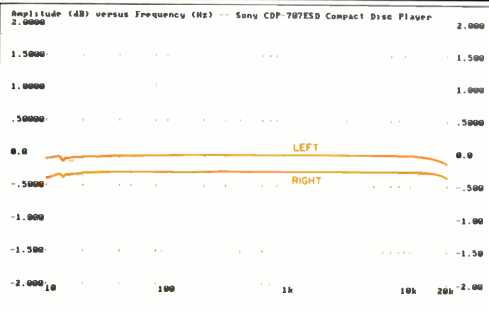
Fig. 1--Frequency response of left and right channels; curves have been separated
for clarity.
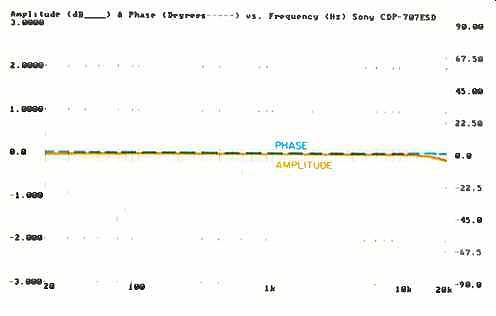
Fig. 2--Comparison between amplitude response of one channel (solid curve)
and relative phase response (dashed curve) of opposite channel. Phase, in
degrees, can be read from right-hand scale.

Fig. 3--Residual noise vs. frequency for "quiet" track of CD-1 test
disc. Note low noise level at 60-Hz power-line frequency and its multiples
(see text).
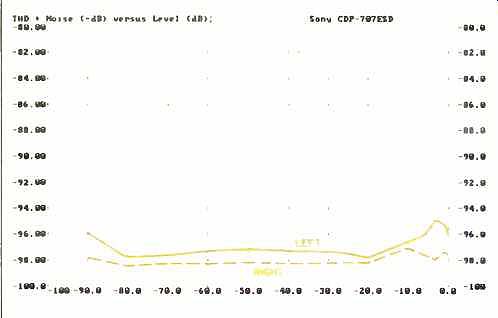
Fig. 4--Quantization noise and distortion vs. signal level.
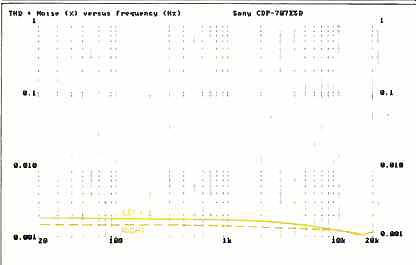
Fig. 5--Quantization noise and distortion vs. frequency. Note decrease at
high frequencies (see text).
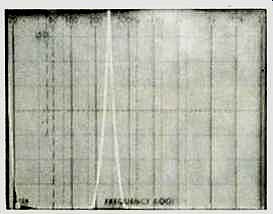
Fig. 6--Spectrum analysis of 20-kHz signal; note absence of 24.1-kHz "beat" tone
seen on many other players. (Vertical scale: 10 dB/div.)
Perhaps even more amazing is the fact that this THD , N level, rather than increasing at higher frequencies because of non-harmonically related out-of-band "beats," actually decreased as the test frequencies approached 20 kHz, as shown in Fig. 5. To confirm this phenomenon, I applied a 20 kHz test signal to a spectrum analyzer, as I have been doing now with most CD players I test, to generate the 'scope photo of Fig. 6. The sweep is, as usual, linear from 0 Hz to 50 kHz, but there is absolutely no evidence of the 24.1-kHz beat so commonly seen from most players. I even stepped up the gain of the analyzer to just below its own clipping level in order to display a full 80 dB of dynamic range on the 'scope. (I usually settle for 70 dB, in order to leave a safety margin for the analyzer's circuits.) Even then, there were absolutely no spurious products--only the desired signal at 20 kHz, where it belonged. If I had any doubts about the benefits of eight-times oversampling or of 18-bit D/A conversion and digital filtering, Figs. 5 and 6 dispelled those doubts completely! Figure 7 is a plot of separation between channels; the results from left to right and from right to left were so close to each other that I did not bother to identify which curve is which. Suffice it to say that at 1 kHz, separation in either direction was greater than 125 dB, and that at 20 kHz, where separation often decreases to 70 dB or less, it still measured well over 100 dB! Next, I investigated an important (and excellent) characteristic of the CDP-707ESD, its linearity. When reproducing undithered test signals, the player showed virtually no deviation from perfect linearity from 0 dB (maximum level) down to about-80 dB. In other words, output levels were almost perfectly proportional to the signal levels recorded digitally on the test disc. There was a very slight departure from linearity at 90 dB, but this was very hard to see in a conventional linearity graph (output versus input amplitude). This is where one of the "procedure" files supplied with my new CD test software comes in. In a series of computations and corrections, the file translates the measured output-versus-input linearity data into a graph that shows deviation from flatness with decreasing level. Here, in Fig. 8, it is much easier to see that at -90 dB, linearity was off by a mere 2.0 dB. The CD-1 test disc contains low-level signals (from 70 to 100 dB) to which dither noise has been added. Although dither reduces the ultimate signal-to-noise ratio of a recording, it also reduces distortion. To put it another way, it extends linear operation below the undithered theoretical limit. Signals whose peak amplitude is less than one-half the least significant bit's value could never be recorded in a non-dithered system. With dither, signals at such low amplitudes are still converted, since the dither acts to ensure that the lowest significant bit is always exercised. If this seems hard to fathom, think of dither in the frequency domain as spreading the quantization noise across the spectrum, rather than having all the energy concentrated at harmonics of the desired signal frequency.
In any event, Fig. 9 is a plot similar to that of Fig. 8, but using signals which are dithered and which extend only from 70 to -100 dB. Again, the deviation from perfect linearity is only about 2 dB (a bit more in one channel, but a bit less in the other) at 100 dB! Two methods for measuring a CD player's dynamic range have been proposed. The first, offered by the Electronics Industries Association of Japan, involves measuring the THD + N of a-60 dB signal, expressing it in dB, and adding the negative number of dB to-60 dB. Spot readings of my test equipment yielded an EIAJ dynamic range of approximately 98 dB for the CDP-707ESD. A second method, proposed by the Electronics Industries Association, utilizes a special dithered signal on the CD-1 test disc that "fades" from 60 to -120 dB (into the noise). Dynamic range is then considered to be the difference between 0 dB (maximum level) and the point during the fade where the signal level is 3 dB higher than the lowest point it ever reaches. In the past, I have tried to measure this point by eyeballing an a.c. voltmeter, but I've found that, at best, results have been none too accurate. Thanks to another "procedure" file created by Audio Precision, the task became quite simple. The system performed a complex series of tests, computations, translations from time frame to level, and the like. During the first stage of this multiple-test procedure, I was able to easily pick out the reading that was 3 dB above the minimum reading; it was -111 dB, which therefore is the EIA dynamic range of this CD player. The final results of this procedure are plotted in Fig. 10, a graph of departure from perfect linearity down to -120 dB. Despite the greatly increased sensitivity of my new test equipment over the gear I had been using, the wow-and flutter test, conducted as a function of time for a period of 25 S, yielded a line along the "0" baseline of the grid on which it was plotted. As they so often say in the published specs, wow and flutter was "below measurable limits"--even though those limits have now been extended downward by a couple of orders of magnitude.
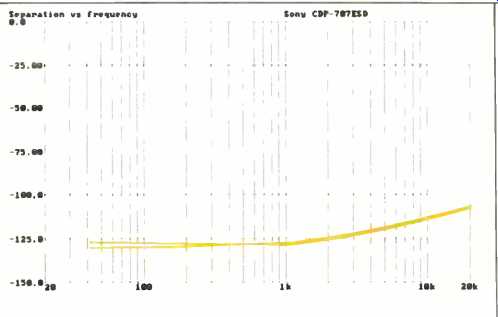
Fig. 7--Interchannel separation. Note the unusually close match between
the two curves (see text).
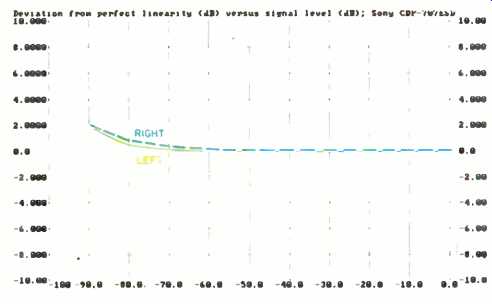
Fig. 8--Deviation from perfect linearity for undithered 1-kHz signal a levels
from -90 to 0 dB.
SMPTE IM was measurable. I read 0.006% for one channel and 0.005% for the other. CCIF twin-tone distortion, using 11- and 12-kHz test signals from the CD-1 test disc, was 0.00123% on either channel. Clock accuracy-the accuracy of the player's 44.1-kHz master clock-is another parameter I am now able to test. Any gross errors in clock accuracy would result in a deviation from correct musical pitch when playing CDs. No such worry with the CDP707ESD: Its clock was off by only 0.0175%. To put it in perhaps more meaningful terms for those of you who study music, a 440-Hz tone (A above middle C) reproduced on this player will come out as 440.07 Hz.
Figures 11 and 12 show how the player reproduced a 1 kHz square wave and a unit pulse, respectively. The slight ripple on the horizontal portions of the square wave are due to the CD system's bandwidth limitation (cutoff at 20 kHz) and not to any other cause. The unit pulse merely confirms that this player does not invert polarity.
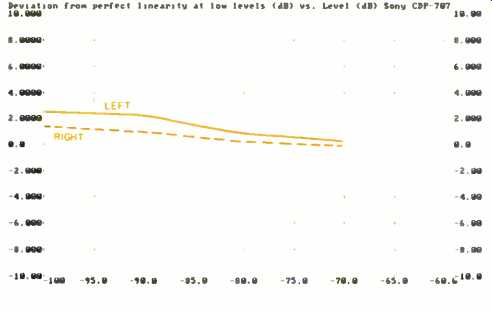
Fig. 9--Deviation from perfect linearity for dithered 1-kHz signal at levels
from -100 to -70 dB.
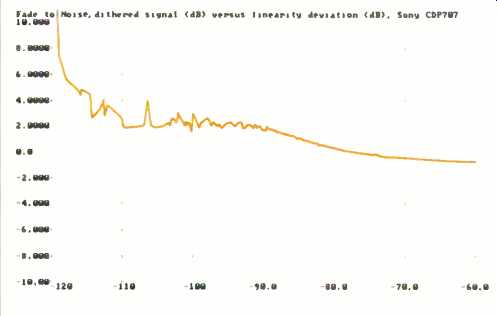
Fig. 10--Linearity deviation for EIA "fade-to-noise" dynamic-range
test, using dithered signal.
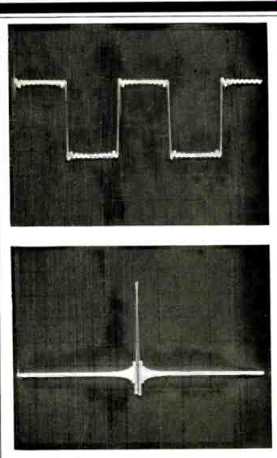
(top) Fig. 11--Reproduction of 1-kHz square wave. (above)
Fig.
12--Single-pulse test.
Use and Listening Tests
The Sony CDP-707ESD is so well constructed, and its laser pickup assembly so well isolated from the rest of the unit, that even rather severe pounding on its top surface failed to cause any mist racking. When I finally got the unit to mis-track, by hitting its side panels rather hard, it did not skip all over the disc, as other players have done. Instead, there was only a brief moment of muting and then a resumption of play at almost precisely the point where the music had been interrupted.
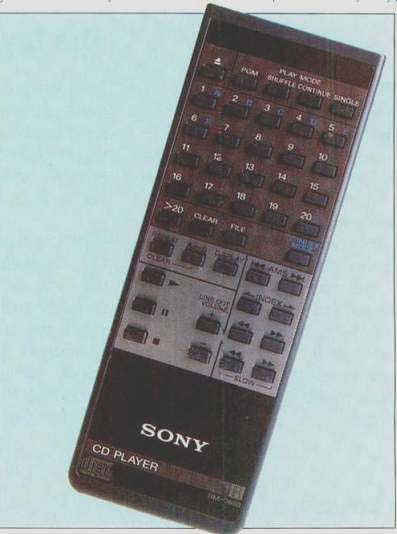
above: The remote control.
The "Disc Memo" feature is intriguing. I don't know what 10-letter messages people will assign to their discs, but if nothing else, the feature is fun to use and experiment with.
The "Custom Index" function, on the other hand, I consider to be extremely useful. I own many discs to which I would like to assign my own index points, in order to more easily find musical passages that I enjoy listening to or that I use in testing audio equipment performance. With the "Custom Index" feature, I could identify these passages easily and recall them accurately. It is a credit to this unit's designers that although the English-language owner's manual was unavailable when I tested the CDP-707ESD (such manuals are, of course, available now), I was able to figure out just about all of its regular functions--and even its unique special features--without too much trouble.
When you get beyond all the clever features, a top-of-the line CD player is expected to reproduce music as accurately and as faithfully as the CD medium will permit. To my way of thinking, the CDP-707ESD does just that. I will not list all of the discs I auditioned on this player; to do so would make an already long report even longer. Three that stand out, though, are a Telarc disc (CD-80142) of Mendelssohn's "Quartet in A Minor" and his "Octet in E Flat Major," a Delos disc (D/CD 3062) which contains Haydn's Symphony No. 21 in A Major as well as his Cello Concerto No. 1 in C Major, and another Telarc disc (CD-80155) of Brahms' Symphony No. 4 in E Minor as well as his "Academic Festival Overture." There's enough variety on these three discs to put any audio system through its paces. I particularly like to play music of small instrumental groups when judging a CD player or, for that matter, any audio component. The clarity and warmth of the cello on that Delos disc has never been reproduced more faithfully than on this Sony player. Even if you can't afford a CDP-707ESD, you owe it to yourself to listen to how it performs and to try out its unique features.
If nothing else, the CDP-707ESD should serve us all as a reference against which to judge the new crop of players that will appear in the coming months. Perhaps they too will employ true 18-bit D/A converters (some already do), eight times oversampling with 18-bit digital filters, and all the other circuit innovations found in this unit. But until they arrive, the Sony CDP-707ESD stands alone as a shining example of what Compact Disc technology is all about.
-Leonard Feldman
(Audio magazine, Apr. 1988)
Also see:
Sony CDP-705ESD Compact Disc Player (July 1987)
Sony CDP-X77ES CD Player (Jun. 1990)
Sony CDP-620ES CD Player (Sept. 1985)
Sony CDP-610ES CD Player (Nov. 1984)
Sony CDP-650ESD Compact Disc Player (July 1985)
= = = =